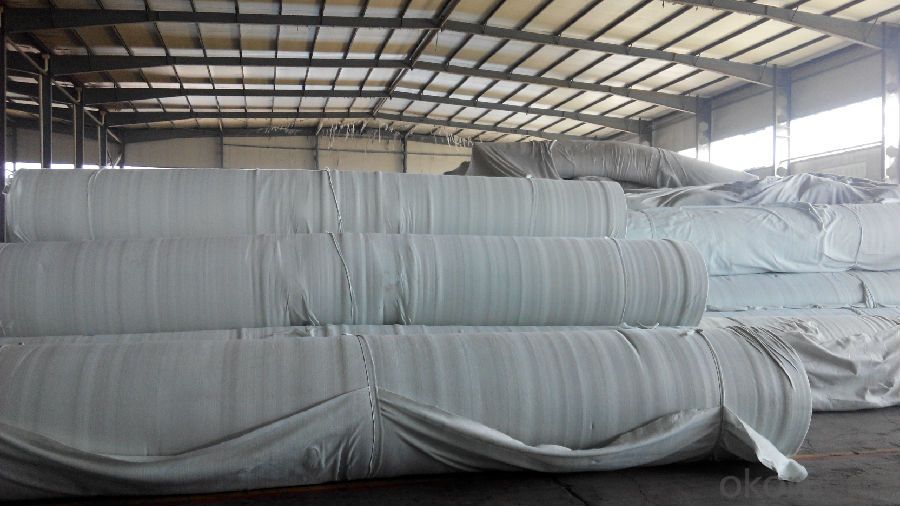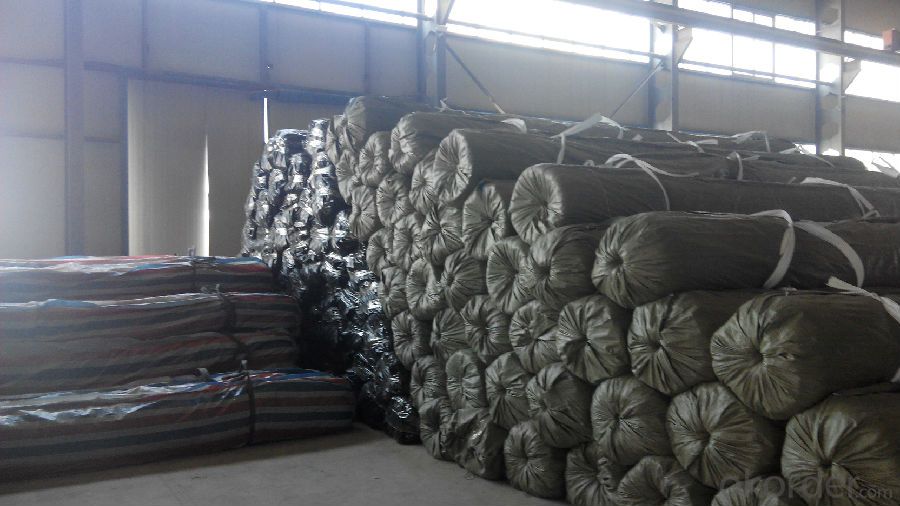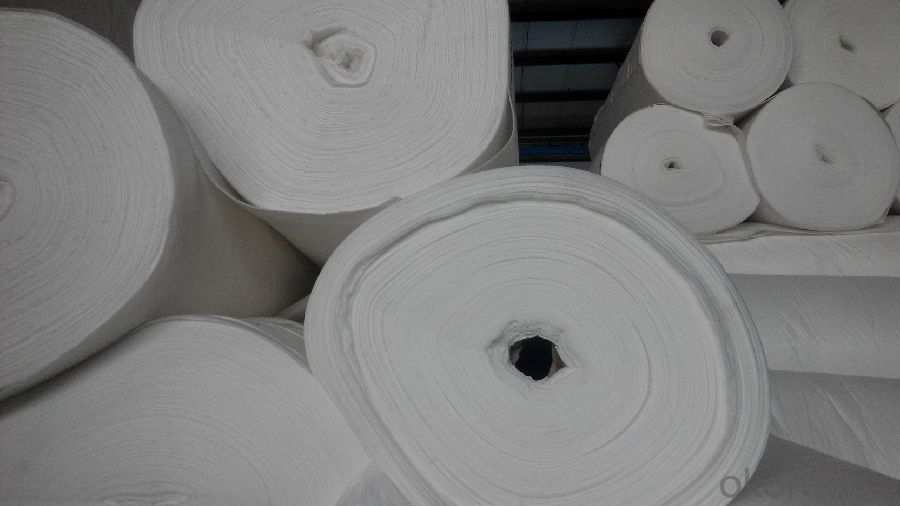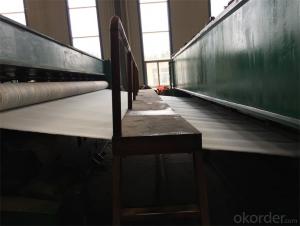PP/PET Needle Punched Non-Woven Geotextile/Non-Woven Geotextile
- Loading Port:
- Qingdao
- Payment Terms:
- TT or L/C
- Min Order Qty:
- 10000 m²
- Supply Capability:
- 100000 m²/month
OKorder Service Pledge
OKorder Financial Service
You Might Also Like
1. Non Woven Geotextile Specificatioin:
Properties | Unit | PET100 | PET150 | PET200 | PET250 | PET300 | PET350 | PET400 | PET450 | PET500 | PET600 | PET800 | |
Tensile Strength | MD | KN/m | 2.5 | 4.5 | 6.5 | 8 | 9.5 | 11 | 12.5 | 14 | 16 | 19 | 25 |
TD | KN/m | 2.5 | 4.5 | 6.5 | 8 | 9.5 | 11 | 12.5 | 14 | 16 | 19 | 25 | |
Tear Strength | MD | KN≥ | 0.08 | 0.12 | 0.16 | 0.2 | 0.24 | 0.28 | 0.33 | 0.38 | 0.42 | 0.46 | 0.6 |
TD | KN≥ | 0.08 | 0.12 | 0.16 | 0.2 | 0.24 | 0.28 | 0.33 | 0.38 | 0.42 | 0.46 | 0.6 | |
CBR Plunger Strength | KN≥ | 0.3 | 0.6 | 0.9 | 1.2 | 1.5 | 1.8 | 2.1 | 2.4 | 2.7 | 3.2 | 4 | |
Elongation at Yield | MD | % | 25-100 | ||||||||||
TD | % | 25-100 | |||||||||||
Hole Size | O90 | mm | 0.07-0.2 | ||||||||||
(O95) | |||||||||||||
Vertical Permeability | cm/s | k*(10-1~10-3),k=1.0~9.9 | |||||||||||
Identification Properties | |||||||||||||
Material | / | Polyester | |||||||||||
Color | / | White | |||||||||||
Thickness | mm, ≥ | 0.9 | 1.3 | 1.7 | 2.1 | 2.4 | 2.7 | 3.0 | 3.3 | 3.6 | 4.1 | 5.0 | |
Weight Unit Area | g/m² | 100 | 150 | 200 | 250 | 300 | 350 | 400 | 450 | 500 | 600 | 800 | |
Width | m | 1m-6m | |||||||||||
2. Non Woven Geotextile Introduction:
Nonwoven geotextiles are manufactured from the extrusion of polypropylene fibres which are then laid down on a manufacturing "bed" and then needle punched to entangle the fibres such that a dimensionally stable product is formed. Some additional thermal treatment is then applied to further improve the strength of the geotextile. Because of this manufacturing process non-woven geotextiles are generally best used in applications of drainage, filtration and protection
3. Non Woven Geotextile Features:
Wide-width rolls
Quality Certified
Proven for use in Main Roads works
Large range to suit the application
4. Non Woven Geotextile Application:
(1) artificial filling foundation movement of ground water.
(2) gravel filter layer surrounding the periphery of the drain pipe drain.
(3) in water conservancy projects wells, relief wells or inclined pipe filter.
(4) for retaining wall backfill reinforcement, or for anchored retaining wall panel.
(5) reinforced flexible pavements, crack repair roads, prevent the reflection cracks of pavement.
(6) in ternal vertical or horizontal drainage, dissipation of pore water pressure in soil.
(7) water impermeable geomembrane dam or embankment in the lower part of the back or the concrete.
(8) the isolation layer between the road ballast and subgrade, isolation layer or between the embankment and soft foundation.
(9) the isolation layer soil between highway, airport, railway ballast and artificial rockfill and soil fabric.
5. Non Woven Geotextile Product Show:



FAQ of our geotextile:
- Q: What can we do for the special customer?
A: Provide custom made service with customer's drawing; We make sure to provide you with the best solutions for your individual case. Whether standard items or non-standard items.
- Q: What can we supply?
A: We provide high levels of communication from start to finish.
- Q: What is our advantage?
A: Top Cemented Carbide has extensive business experience, Fast delivery and high quality.
Over the past decade a greater emphasis has been placed on the development and manufacturing of geosynthetic textiles. While the geosynthetics industry is comparatively new, it has already created products with applications in a wide range of industries including geotechnical, transportation, hydraulic, embankment management, and mining. In many cases, a single geosynthetic textile can solve or improve multiple civil engineering problems simultaneously.
The first example of a geosynthetic textile application is the use of a prefabricated pocket style vertical drain made from a nonwoven filter jacket specialized as a PVD filter material. The purpose of this product was to reduce the time needed for construction by quickly discharging water in the ground which speeds up the soil consolidation process. Overall, it proved to reduce construction time and speed up the consolidation of soft ground in a variety of different situations including road construction, the development of building sites, construction of gas and oil storage facilities, and bank revetment.
The second example of how geosynthetic textiles can provide solutions to civil engineering problems is the polyester woven geotextile mat. It is created from a high tenacity polyester filament which is highly dense. This particular geosynthetic textile has been used to reinforce soft ground and embankments, separate layers of sand and soft ground, prevent the uneven settlement of soft ground, and securing a safe path of travel for heavy equipment across soft ground.
- Q:What kind of geotextiles are used in highway geotextiles?
- Highway geotextile general use Hongxiang new material filament geotextile, to overcome the cracks and so on the road defects.
- Q:What are the factors to consider when selecting geotextiles for embankment stabilization?
- When selecting geotextiles for embankment stabilization, several factors should be considered. These include the strength and durability of the geotextile, its ability to withstand environmental conditions such as sunlight exposure and chemical degradation, its filtration and drainage properties, and its compatibility with the soil and other materials used in the embankment. Additionally, factors such as cost, installation requirements, and the specific project requirements and goals should also be taken into account.
- Q:How are geotextiles used in agricultural applications?
- Geotextiles are used in agricultural applications to control soil erosion, improve water drainage, and provide stabilization for slopes. They are often placed under roads, walkways, and erosion-prone areas to prevent soil erosion and maintain the integrity of the land. Additionally, geotextiles can act as a filter to separate fine particles from larger ones, allowing for better water drainage and preventing clogging in drainage systems. Overall, geotextiles play a crucial role in enhancing agricultural practices and preserving the health of the soil.
- Q:This is a large sample of gravel anti-filter how this project count
- Lack of slope and total length, can not accurately calculate the amount of engineering. Approximate estimates of cross-sectional area, then only a few simple graphics: clay tamping (rectangular), coarse gravel (trapezium), gravel and gravel (zoned plus parallel quadrilateral), geotextile (four sections)!
- Q:Geotextile what is the law?
- Geotextile, also known as geotextile, it is made of synthetic fiber through acupuncture or woven from the permeability of geosynthetics. The American Society of Agricultural Engineers defines geotextiles as geotextiles or geosynthetics that exist between soils and pipelines, gages, or retaining walls that enhance water movement and impede soil movement. ASTM 4439 standard geotextile is defined as: a purely permeable geosynthetics to form textiles. Is used in soil, rock, soil or other geotechnical engineering related materials and acts as a component of a human-made project. Geotextile is a new type of building materials, raw materials are polyester, polypropylene, acrylic, nylon and other polymer polymer synthetic fiber. In accordance with the manufacturing method is divided into: there are two types of geotextile and non-woven geotextile. General engineering is mainly used non-woven geotextile. Geotextile with filter, filter, isolation, reinforcement, protection, sealing and other functions.
- Q:What are the considerations for geotextile selection in riverbank stabilization?
- There are several important considerations for geotextile selection in riverbank stabilization. Firstly, the geotextile must have sufficient strength and durability to withstand the hydraulic and environmental conditions of the specific riverbank. Additionally, it should have good filtration properties to prevent soil erosion and promote water drainage. The geotextile's permeability and porosity are also crucial factors, as they determine the rate of water flow and allow for proper drainage. Lastly, the geotextile should be compatible with other materials used in the stabilization process and be able to withstand any chemical exposure or biological degradation that may occur in the riverbank environment.
- Q:Can geotextiles be used in coastal revetment works?
- Yes, geotextiles can be used in coastal revetment works. Geotextiles are often used in coastal engineering projects as they provide erosion control, stabilization, and protection against wave action and tidal forces. They can be installed as a barrier between the revetment material and the underlying soil, preventing soil erosion and enhancing the overall stability of the revetment structure. Geotextiles also allow for proper drainage and filtration, reducing the risk of sediment buildup and enhancing the longevity of the revetment works.
- Q:Unit of the quality of 400 geotextile piercing strong is generally how much? Hurry more
- First, geotextile polyester staple fiber geotextile (PET) and polyester filament geotextile two. Two kinds of geotextile anti-puncture strong (should be CBR burst strong) different. Polyester staple geotextile in accordance with the national standard GB / T-2008 standard implementation, 400g GB polyester staple geotextile CBR burst strength ≥ 2.1KN. Polyester filament geotextile in accordance with the national standard GB / T-2008 standard implementation, 400g GB polyester filament geotextile CBR burst strength ≥ 39KN. 400g GB polyester staple geotextile longitudinal and horizontal tear strength ≥ 0.33KN, 400g GB polyester filament geotextile longitudinal and horizontal tear strength ≥ 0.56KN.
- Q:Geotextile how much money
- Specifications of different quality prices ranging from geotextiles from November last year to the current price rose too much
- Q:How do geotextiles aid in the reduction of liquefaction?
- Geotextiles aid in the reduction of liquefaction by providing reinforcement and stabilization to the soil. These synthetic fabrics are installed beneath the surface to improve the soil's strength and prevent its excessive movement during seismic activity. By increasing the soil's resistance to liquefaction, geotextiles help to mitigate the potential damage and hazards caused by this phenomenon.
1. Manufacturer Overview |
|
|---|---|
| Location | Taian City,Shandong Province,China |
| Year Established | 2008 |
| Annual Output Value | Above US$100 Million |
| Main Markets | Africa, Oceania, North America, Western Europe, Eastern Asia |
| Company Certifications | ISO9001;IS014001 Certificate |
2. Manufacturer Certificates |
|
|---|---|
| a) Certification Name | |
| Range | |
| Reference | |
| Validity Period | |
3. Manufacturer Capability |
|
|---|---|
| a)Trade Capacity | |
| Nearest Port | Qingdao Port;Tianjing Port;Shanghai Port |
| Export Percentage | |
| No.of Employees in Trade Department | 21-30 People |
| Language Spoken: | English; Chinese; |
| b)Factory Information | |
| Factory Size: | 10,000-30,000 square meters |
| No. of Production Lines | Above 10 |
| Contract Manufacturing | Geotechnical Material (Geogrid,Fiberglass/Polyester Geogrid,Geocell,Geonet and Geomat,Plastic Safety Fence) |
| Product Price Range | Average |
Send your message to us
PP/PET Needle Punched Non-Woven Geotextile/Non-Woven Geotextile
- Loading Port:
- Qingdao
- Payment Terms:
- TT or L/C
- Min Order Qty:
- 10000 m²
- Supply Capability:
- 100000 m²/month
OKorder Service Pledge
OKorder Financial Service
Similar products
New products
Hot products
Hot Searches
Related keywords
































